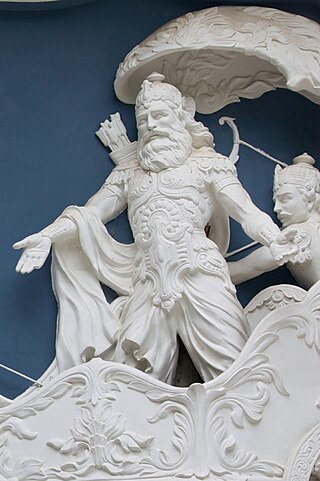Related Research Articles

Kshatriya is one of the four varnas of Hindu society and is associated with the warrior aristocracy. The Sanskrit term kṣatriyaḥ is used in the context of later Vedic society wherein members were organised into four classes: brahmin, kshatriya, vaishya, and shudra.
The Maratha caste is composed of 96 clans, originally formed in the earlier centuries from the amalgamation of families from the peasant (Kunbi), shepherd (Dhangar), blacksmith (Lohar), carpenter (Sutar), Bhandari, Thakar and Koli castes in Maharashtra. Many of them took to military service in the 16th century for the Deccan sultanates or the Mughals. Later in the 17th and 18th centuries, they served in the armies of the Maratha Empire, founded by Shivaji, a Maratha Kunbi by caste. Many Marathas were granted hereditary fiefs by the Sultanates, and Mughals for their service.

House of Scindia is a Hindu Maratha Royal House that ruled the erstwhile Gwalior State in central India. It had the Patil-ship of Kanherkhed in the district of Satara and was founded by Ranoji Shinde, who started as a personal servant of the Peshwa Bajirao I. Ranoji and his descendants, along with their rivals the Holkars, played a leading role during the Maratha ascendancy in northern India in the 18th-century. The Gwalior State became a princely state during the British Raj in the 19th and the 20th-centuries. After India's independence in 1947 and the abolition of princely states, several members of the Scindia (Shinde) family went on to enter Indian politics.
The Bhonsle are a prominent group within the Maratha clan system.

Kunbi is a generic term applied to several castes of traditional farmers in Western India. These include the Dhonoje, Ghatole, Masaram, Hindre, Jadav, Jhare, Khaire, Lewa, Lonare and Tirole communities of Vidarbha. The communities are largely found in the state of Maharashtra but also exist in the states of Madhya Pradesh, Gujarat, Karnataka, Kerala and Goa. Kunbis are included among the Other Backward Classes (OBC) in Maharashtra.
The Patil is an Indian last name and a title or surname. The female variant of the title is Patlin or Patlinbai, and is also used to describe the wife of a Patil.
The Dhangars are a herding caste of people found in the Indian states of Maharashtra, Karnataka, Goa, Madhya Pradesh and Uttar Pradesh. They are referred as Gavli in southern Maharashtra, Goa and northern Karnataka, Golla in Andhra Pradesh and Karnataka and Ahir in northern Maharashtra. Some Gavlis live in forested hill tracts of India's Western Ghats. Gavli, also known as Dange or Mhaske, and Ahir are a sub-caste of Dhangar. However, there are many distinct Gavli castes in Maharashtra and Dhangar Gavli is one of them.
Chandraseniya Kayastha Prabhu (CKP) or historically and commonly known as Chandraseniya Prabhu or just Prabhu is an ethnic group mainly found in Gujarat and Maharashtra. Historically, they made equally good warriors, statesmen as well as writers. They held the posts such as Deshpande and Gadkari according to the historian, B.R. Sunthankar, produced some of the best warriors in Maharashtrian history.

The Marathi people or Marathis are an Indo-Aryan ethnolinguistic group who are native to Maharashtra in western India. They natively speak Marathi, an Indo-Aryan language. Maharashtra was formed as a Marathi-speaking state of India on May 1, 1960, as part of a nationwide linguistic reorganisation of the Indian states. The term "Maratha" is generally used by historians to refer to all Marathi-speaking peoples, irrespective of their caste; However, it may refer to a Maharashtrian caste known as the Maratha.
The caste system in Goa consists of various Jātis or sub-castes found among Hindus belonging to the four varnas, as well as those outside of them. A variation of the traditional Hindu caste system was also retained by the Goan Catholic community.
Hatkar, also known as Bargi Dhangar is the warrior caste found in Deccan region of India. Their home language is Marathi. However, Bargi is a distinct sub-caste from Hatkar Dhangar.
Bhoite is a surname found amongst the Maratha caste, mainly in the state of Maharashtra in India but it also appears in Indian states bordering Maharashtra.

Morè is originally the surname of a Maratha warrior clan from Maharashtra, India. Mahars started to use the More surname after 1900s, just like they adopted many other Maratha surnames. Members of the More Maratha clan as well as the Mahar clan use the clan name as their surname. The totem (devak) associated with the clan is a peacock feather (Mayurpankh).
Shivaji was the founder of the Maratha Empire in the Indian subcontinent. This article describes Shivaji's life from his birth until the age of 19 years (1630–1649).
The Shegar Dhangar is a Hindu caste.

Vishweshwara Pandit, popularly known as Gaga Bhatt, was a 17th-century Brahmin scholar from Varanasi, best known for presiding over the pan-Indian Brahminical committees convened by Shivaji to adjudicate the caste status of the Syenavi Gaud Saraswat Brahmins, who claimed Brahmin rank, and the Chandraseniya Kayastha Prabhus, who claimed to be Kshatriyas, before taking up the matter of Shivaji's own caste and eligibility for investiture with the sacred thread (Upanayana), coronation as Chhatrapati (Abhisheka), and participation in other high rituals.
Pisal is surname mainly found amongst the 96 Maratha clans.
Gavli, Gawli or Gavali is a Hindu caste found in the Indian states of Maharashtra and Madhya pradesh. They a part of the Yadav community.
Annaji Datto Sachiv was the Sachiv in the Ashta Pradhan mandal of the Maratha Empire during the rule of Shivaji.

The Bhonsle dynasty are a prominent Indian Marathi royal house. They claimed descent from the Rajput Sisodia dynasty, but were likely Kunbi Marathas.
References
- ↑ "Maratha (people)". Encyclopædia Britannica. Encyclopædia Britannica Online. 2009.
- 1 2 Stewart Gordon (16 September 1993). The Marathas 1600-1818. Cambridge University Press. pp. 15–17. ISBN 978-0-521-26883-7.
Looking backward from ample material on the eighteenth and nineteenth centuries, we know that Maratha as a category of caste represents the amalgamation of families from several castes - Kunbi, Lohar, Sutar, Bhandari, Thakar, and even Dhangars (shepherds) – which existed in the seventeenth century and, indeed, exist as castes in Maharashtra today. What differentiated, for example, "Maratha" from "Kunbi"? It was precisely the martial tradition, of which they were proud, and the rights (watans and inams) they gained from military service. It was these rights which differentiated them from the ordinary cultivator, ironworkers and tailors, especially at the local level
- 1 2 Abraham Eraly (2000). Emperors of the Peacock Throne: The Saga of the Great Mughals. Penguin Books India. p. 435. ISBN 978-0-14-100143-2.
The early history of the marathas is obscure, but they were predominantly of the sudra(peasant) class, though later, after they gained a political role in the Deccan, they claimed to be Kshatriyas(warriors) and dressed themselves up with pedigrees of appropriate grandeur, with the Bhosles specifically claiming descent from the Sidodia's of Mewar. The fact however is that the marathas were not even a distinct caste, but essentially a status group, made up of individual families from different Maharashtrian castes..
- 1 2 John Keay (12 April 2011). India: A History. Open Road + Grove/Atlantic. p. 565. ISBN 978-0-8021-9550-0.
marathas not being accounted as of kshatriya status, a false genealogy had to be fabricated
- 1 2 Christophe Jaffrelot (2006). Dr Ambedkar and Untouchability: Analysing and Fighting Caste. Permanent Black. p. 39. ISBN 978-81-7824-156-2.
His theory, which is based on scant historical evidence , doubtless echoed this episode in Maharashtra's history,whereas in fact Shivaji, a Maratha-Kunbi, was a Shudra. Nevertheless, he had won power and so expected the Brahmins to confirm his new status by writing for him an adequate genealogy. This process recalls that of Sanskritisation, but sociologists refer to such emulation of Kshatriyas by Shudras as ' Kshatriyaisation ' and describe it as a variant of Sanskritisation.
- 1 2 M. S. A. Rao (1989). Dominance and State Power in Modern India: Decline of a Social Order. Oxford University Press. p. XVI. ISBN 978-0-19-562098-6.
An indication that the Shudra varna of elite marathas remained unchanged was the maratha practice of hypergamy which permitted inter-marriage with rising peasant kunbi lineages, and created a hierarchy of maratha kuls, whose boundaries were flexible enough to incorporate, by the twentieth century, most of the kunbi population.
- ↑ John Vincent Ferreira (1965). Totemism in India. Oxford University Press. pp. 191, 202.
Together with the Marathas, the Maratha Kunbi belonged originally, says Enthoven, to the same caste; and both their exogamous kuls and exogamous devaks are identical with those of the Marathas. Enthoven opines that the totemic nature of their devak system suggests that they are largely of a non-Aryan origin. ... The Kunbi cultivators are also Marathas but of a somewhat inferior social standing. The Maratha claim to belong to the ancient 96 Kshatriya families has no foundation in fact and may have been adopted after the Marathas became with Shivaji a power to be reckoned with.
- ↑ Kulkarni, G.T. (1991). "Deccan (Maharashtra) Under the Muslim Rulers from Khaljis to Shivaji: A Study in Interaction". Bulletin of the Deccan College Research Institute. 51/52: 501–510. ISSN 0045-9801. JSTOR 42930434.
- ↑ Eaton, Richard M. (2019). India in the Persianate Age: 1000–1765. Penguin UK. p. 198. ISBN 978-0-14-196655-7.
- ↑ Stewart Gordon (2007). The Marathas 1600–1818. Cambridge University Press. p. 85. ISBN 978-0-521-03316-9.
- ↑ Gordon, Stewart (16 September 1993). "Shivaji (1630–80) and the Maratha polity" (PDF). The Marathas 1600–1818. The New Cambridge History of India. p. 69. doi:10.1017/CHOL9780521268837. ISBN 978-0-521-26883-7.
{{cite book}}:|journal=ignored (help) - 1 2 Carter, A. T. (1973). "A Comparative Analysis of Systems of Kinship and Marriage in South Asia". Proceedings of the Royal Anthropological Institute of Great Britain and Ireland. 1973 (1973): 29–54. doi:10.2307/3031719. JSTOR 3031719 . Retrieved 27 September 2020.
- ↑ Kathleen Kuiper, ed. (2010). The Culture of India. Rosen. p. 34. ISBN 9781615301492.
- ↑ Rosalind O'Hanlon (2002). Caste, Conflict and Ideology: Mahatma Jotirao Phule and Low Caste Protest in Nineteenth-Century Western India. Cambridge University Press. pp. 17–. ISBN 9780521523080 . Retrieved 13 May 2011.
- ↑ Louis Dumont (1980). Homo hierarchicus: the caste system and its implications. University of Chicago Press. p. 121. ISBN 9780226169637 . Retrieved 13 May 2011.